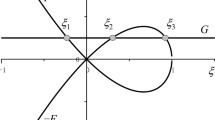Abstract
Vibration equations of time-varying system are transformed to the form which is suitable to precise integration algorithm. Precision analysis and computation efficiency of new algorithm are implemented. The following conclusions can be got. Choosing matrixes M, G and K is certainly flexible. We can place left side of nonlinear terms of vibration equations of time-varying system into right side of equations in precise integration algorithms. The key of transformation from vibration equations of time-varying system to first order differential equations is to form matrix H, which should be assured to be nonsingular. With suitable disposal, precision and computation efficiency of precise integration algorithms are greatly larger than those of general methods.
Similar content being viewed by others
References
ZENG Qing-yuan, GUO Xiang-rong. Theory of vibration analysis of railway-bridge time-varying system and its applications [M]. Beijing: China Railway Publishing House, 1999. (in Chinese)
ZENG Qing-yuan, XIANG Jun, LOU Ping. A breakthrough in solving the problem of train derailment-The approach of random energy analysis [J]. Engineering Science, 2002, 4(12): 9–20. (in Chinese)
CHEN Rui-lin. The study on the value of kinematic stability coefficent of submarine in vertical plane [J]. Natural Science Journal of Xiangtan University, 2003(4): 71–75. (in Chinese)
ZHAI Wan-ming. Two simple fast integration methods for large-scale dynamic problems in engineering [J]. International Journal for Numerical Methods in Engineering, 1996, 39(24): 4199–4214.
ZHAI Wan-ming. Coupling danamics of train-rail system (third edition) [M]. Beijing: China Railway Publishing House, 2007. (in Chinese)
ZHONG Wan-xie. Computational structure dynamics and optimal control [M]. Dalian: Dalian University of Technology Press, 1993. (in Chinese)
LIU Zhen-xing, SUN Yan, WANG Guo-qing. Computational solid mechanics[M]. Shanghai: Shanghai Jiaotong University Press, 2000. (in Chinese)
QIU Chun-hang, LU He-xiang, CAI Zhi-qin. Solving the problems of nonlinear dynamics based on Hamiltonian system [J]. Chinese Journal of Computational Mechanics, 2000, 17(2): 127–132. (in Chinese)
Author information
Authors and Affiliations
Corresponding author
Additional information
Foundation item: Project(50078006) supported by the National Natural Science Foundation of China
Rights and permissions
About this article
Cite this article
Chen, Rl., Zeng, Qy. & Zhang, Jy. New algorithm applied to vibration equations of time-varying system. J. Cent. South Univ. Technol. 15 (Suppl 1), 57–60 (2008). https://doi.org/10.1007/s11771-008-0314-2
Received:
Accepted:
Published:
Issue Date:
DOI: https://doi.org/10.1007/s11771-008-0314-2




